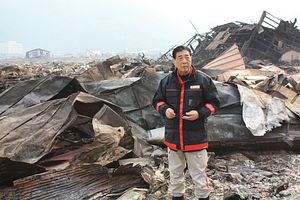Five years ago, in Japan, a devastating earthquake and tsunami triggered an “unthinkable” disaster at the Fukushima nuclear power plant. This year, we also mark 30 years since the 1986 nuclear accident in Chernobyl, Ukraine.
The commemoration of these catastrophic events is an opportunity to reflect on our preparedness to respond to low-probability but high-impact disasters. First and foremost, they should remind us of the long-term humanitarian and environmental costs of nuclear accidents. Today, Red Cross staff and volunteers continue to monitor the effects of radiation on generations who were not alive when these accidents took place. Thirty years after Chernobyl people still face health complications and other challenges in their daily lives that are associated with living in contaminated areas. In Japan, the Red Cross is supporting families through the psychological stresses of displacement. More than 100,000 people from Fukushima are still unable to return home. Many continue to face an uncertain future, living in temporary housing as decontamination efforts continue.
It is clear that as a global humanitarian community we remain ill-equipped to address the very specific and potentially long-lasting needs of people at risk from complex and emerging threats associated with technological hazards. Given the myriad of humanitarian crises that the world is confronting today, some may ask whether it is appropriate to devote time and resources to preparing for rare but potentially high-impact technological accidents such as nuclear emergencies.
However as urbanization and industrialization increase, so too do the risks associated with technological hazards. Other factors such as extreme weather events commonly associated with climate change also leave technological infrastructure exposed to increasingly unpredictable levels of risk.
Fukushima and Chernobyl offer many lessons that must ensure we are better prepared for future disasters and emerging threats. We must start anticipating not just the predictable disasters but also the unthinkable ones. We should build on these lessons and the upcoming World Humanitarian Summit in May is a vital opportunity to galvanize action by building on our experience of community response to emergencies of this nature.
Local, national and international actors all have a role to play in scaling up disaster preparedness, response and recovery activities; but during disasters it is the volunteers of the Red Cross and Red Crescent who are the first responders, working in the hardest environments and most challenging locations. Our experience shows that the most effective humanitarian response relies upon the local reach of these volunteers. Partnership with affected communities is vital and this must work in parallel with good coordination with relevant authorities. Ultimately, national and local systems need to be reinforced, local leadership and capacities respected and strengthened and not undermined through outside interventions. If we want to address the uncommon dangers and challenges related to radiological hazards, a strong commitment to strengthening local capacities is necessary.
A good example is when the humanitarian community partners with local actors to ensure communities get access to risk information. This is critical to community engagement and preparedness where information on technological hazards needs to be openly and transparently communicated. Since Fukushima, many people have chosen to move away and start their lives in new locations. Amongst those who remain are the elderly and vulnerable, some of who may struggle to determine what the acceptable risks are and when to act on trustworthy information. Added to these stresses is the social stigma that many continue to experience. It is our duty to engage local communities in a meaningful dialogue and to work at linking information providers with the general population.
Accompanying people as they take their lives into their own hands again will keep the humanitarian community engaged for many years and we will continue to stand by all the affected people of Fukushima and Chernobyl for as long as we are needed.
Since the Fukushima nuclear disaster, equipment provided by the Japanese Red Cross Society has monitored radiation levels in thousands of residents and also in local foodstuffs. New facilities, health checks, recreational activities and summer camps have been organized for schoolchildren in the area. 800 permanent homes have been constructed for the elderly and social welfare activities run by Red Cross volunteers are continuing. The Red Cross has also set up an information center to gather experiences and lessons from the disaster, and developed an operational manual for their doctors and nurses to use in case of nuclear accidents. The IFRC has also published a set of guidelines for nuclear emergency preparedness, drawing together the considerable experience of the Red Cross and Red Crescent on nuclear accidents.
Tadateru Konoé is President of the International Federation of Red Cross and Red Crescent Societies (IFRC).

































